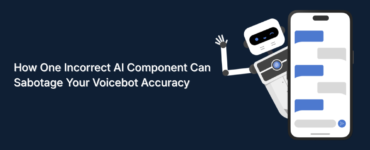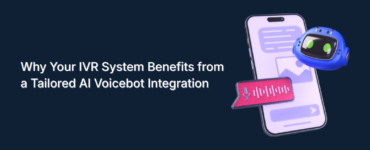The voice AI industry is experiencing rapid growth. In 2024 alone, the global market for AI-powered voice assistants hit $3.54 billion, and it’s projected to cross $4.66 billion by the end of 2025, expanding at a remarkable 31.5% annual growth rate. But here’s the catch: while many companies are eager to adopt voice automation, most of them miss one key element—language fluency. Custom AI Voice Assistants that fail to understand how your customers speak are as good as no bot at all.

It’s not enough for your AI to respond quickly. It needs to respond intelligently. If your assistant can’t handle real conversations, understand different tones, or pick up regional phrases, it’s just another tool that frustrates rather than supports. That’s where Custom AI Voice Assistants make all the difference—they’re built to sound less robotic and more relatable. Let’s explore how to train one that truly speaks your customer’s language.
Start by Listening to Your Customers
Before you build anything, take time to understand how your customers actually speak. Real conversations are messy—they’re full of pauses, emotional cues, slang, and mixed-language phrases. Pull data from customer calls, chats, and feedback forms. You’ll start to see patterns: how they describe problems, how their tone changes based on urgency, and what kind of language they use when they’re frustrated or satisfied. This raw input becomes the foundation of your voice assistant’s personality. Train it on these insights, and your assistant won’t just hear customers—it’ll understand them.
Build for Conversations, Not Commands
Most voice bots are designed to follow commands, not hold conversations. That’s why they often fall flat after the first few interactions. Training a voice assistant means going beyond pre-defined scripts. You need to map how customers move through conversations—how they ask follow-up questions, when they change topics, or how they respond when they don’t understand something. The goal is to make the assistant feel more like a person and less like a menu system. Customers shouldn’t have to “speak AI.” The AI should adapt to how they speak.
Language Is More Than Words—It’s Context
Customers rarely explain everything clearly in one go. They say things like “that plan I asked about” or “the issue I mentioned last week.” To respond properly, your assistant needs to remember what was discussed earlier and carry that context forward. Training your voice AI to handle multi-turn conversations, recognize intent shifts, and connect dots across a session makes interactions more natural and seamless. A well-trained assistant picks up where the user left off—not where the script restarts.
Speak the Way Your Customers Do
If your customers speak in Hinglish or ask questions like, “Recharge karna hai last plan se,” your voice assistant should instantly understand and respond accordingly. This requires proper training in regional languages, accents, and code-mixed speech patterns. A multilingual voice assistant shouldn’t just translate—it should think in the customer’s language. It should also know when to be formal, when to be casual, and when empathy is more important than information. Voice is personal, and personalization depends on how well your assistant speaks like your users.
Know the Language of Your Industry
A voice assistant built for banking should understand what “EMI bounce” means. In telecom, it should instantly respond to “port request failed.” Every industry has its own jargon, phrases, and process flows—and your assistant needs to be fluent in them. Off-the-shelf models don’t know your product names, policies, or workflows. But a custom voice AI development model can be trained on all of that. The more it knows your industry, the more confident and accurate it becomes in every interaction.
Don’t Let the Conversation Fall Apart
Sometimes customers don’t respond the way your assistant expects. They interrupt. Changing topics mid-conversation is common. You’ll often hear things like, ‘Wait, go back,’ or, ‘No, that’s not what I meant.'” Instead of freezing, your assistant should know how to handle these moments smoothly. That means training it on real human behavior, where conversations don’t always follow rules. This helps the assistant stay in control of the experience without frustrating the customer or making them repeat themselves.
Train It. Launch It. Then Keep Teaching It.
Your voice assistant should never stop learning. Once it’s live, start tracking which queries it struggles with, which responses get poor feedback, and what new questions are trending among users. Feed this data back into your system regularly. Add new vocabulary, update flows based on recent product changes, and refine the tone as your brand voice evolves. A smart voice assistant doesn’t just solve today’s queries—it grows smarter for tomorrow.
Final Thoughts
Customers are already talking. The real question is—is your voice AI listening well enough to respond naturally? Building Custom AI Voice Assistants that understand how people speak is no longer a nice-to-have—it’s a necessity. The companies that succeed in voice automation are the ones who understand that people don’t want perfect answers. They want human ones.
Train your Custom AI Voice Assistants to listen better, speak smarter, and connect deeper. When you do that, you don’t just automate support—you earn trust, loyalty, and repeat business.
FAQs
1. What makes a custom voice assistant different from tools like Alexa or Siri?
Custom voice assistants are built and trained specifically for your business. They understand your workflows, terminology, and customer needs—making them far more accurate and reliable than general-purpose tools.
2. Can a voice assistant handle Hindi, Tamil, or other regional languages?
Yes. With the right training data, your assistant can speak, understand, and even switch between regional languages and mixed speech like Hinglish.
3. How long does it take to train a custom voice AI?
Depending on the complexity and data availability, most projects take 6–12 weeks for the first launch, with continuous updates after deployment.
4. What kind of data is needed to train the assistant?
Customer service transcripts, chat logs, FAQs, product documentation, and audio recordings—all of these help build a realistic and effective assistant.
5. Is it possible to update the assistant over time?
Absolutely. The best voice assistants are continuously updated with new phrases, intents, and responses based on real user behavior and feedback.




